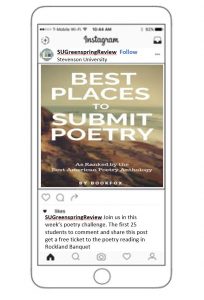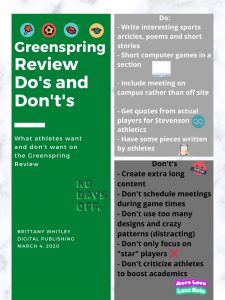
In my mockup of a social media post, I chose Instagram as the main form of social media for the Greenspring Review. Instagram is a social network filled with over 120 million users and most of those being young people. Instagram caters to the youth and college-age students who look to social media for information. The Greenspring Review wants and needs to reach its students at Stevenson and looking to enroll in Stevenson; this is the platform that the audience looks first for the latest information and things about school. I think another important audience is parents. Parents of Greenspring Review writers want to see their child’s published work and probably show it off to their co-workers. This can be done through the Facebook platform. The post on this platform would be more formal and straight to the point of promoting new talent and student work. While the Instagram Post would be more causal as a way to get students interested and aware of programs being put on and how to enter their own work onto the Greenspring Review.
On Instagram, there are many factors that make it the best choice for the Greenspring Review. Once a page is on public, any person can have the ability to direct message (DM) the Greenspring view for questions or comments within minutes to stay in contact with the magazine. On Instagram, there can also be private and public stories that give an interesting aspect of exclusivity for the site to relate messages to certain people, for example, possibly a secret poetry reading late at night and only the people who like this post get to be in the private story for the location. Another good thing about this platform is that the comments amount is pretty much unlimited versus a platform like Twitter that only allows a certain number of characters per post. Emojis are always a good way to capture a follower and keep them interested in the caption attached to the picture. And speaking of photographs, these can be anything from a picture to a flyer to a video or a gif to make the post whatever we want it to be. All forms of mixed media work and mixing up the different media per post is a creative way to keep followers on their toes. Posting frequently, once a day of 3-4 times a week is good for any organization or club because this means they appear on someone’s timeline more often and that is the best way to get your page out there. Ultimately, I believe Instagram is the best platform to promote and use social media for the Greenspring Review.

